Osteoporosis is a condition where the bones become fragile and weak, making them more prone to fractures. It commonly occurs in older adults, especially women, and can significantly impact their quality of life.
But did you know that osteoporosis can be prevented and treated with proper calcium intake? Take our 1-minute osteoporosis test to see if you are at risk.
Who is at Risk for Osteoporosis?
While anyone can develop osteoporosis, some factors increase your risk significantly. These include:.
- Being female
- Being over the age of 50
- Having a small and thin body frame
- Having a family history of osteoporosis
- Being of Caucasian or Asian descent
- Not getting enough calcium and vitamin D
- Not getting enough exercise
- Having a history of smoking and/or heavy alcohol use
If you have any of these risk factors, it’s essential to take steps to prevent osteoporosis.
The 1-Minute Osteoporosis Test
To see if you’re at risk for osteoporosis, take our quick 1-minute test. Answer yes or no to the following questions:.
- Are you a woman over 50?
- Do you have a small and thin body frame?
- Do you have a family history of osteoporosis?
- Are you of Caucasian or Asian descent?
- Do you get less than 3 servings of calcium-rich foods per day?
- Do you get less than 15 minutes of sunlight per day?
- Do you smoke?
- Do you consume more than 2 alcoholic drinks per day?
- Do you get less than 150 minutes of exercise per week?
- Have you had a fracture in the past 10 years?
Add up your yes answers. If you have three or more, you may be at risk for osteoporosis.
Taking Steps to Prevent Osteoporosis
Fortunately, you can take several steps to prevent or manage osteoporosis. These include:.
- Getting enough calcium and vitamin D: Most adults need 1,000-1,200 milligrams of calcium and 600-800 International Units (IU) of vitamin D per day. Calcium-rich foods include milk, cheese, yogurt, tofu, leafy greens, and almonds. Vitamin D is found in fatty fish, eggs, and fortified foods.
- Exercising regularly: Weight-bearing exercises, such as walking, jogging, hiking, and weightlifting, can help strengthen your bones and prevent bone loss.
- Quitting smoking: Smoking can reduce bone density and increase your risk of fractures.
- Limiting alcohol intake: Drinking too much alcohol can weaken your bones and increase your risk of falls.
- Taking medication: If you have severe osteoporosis or a high risk of fractures, your doctor may prescribe medication to help increase your bone density and prevent fractures.
Talk to your doctor if you’re at risk for osteoporosis to develop a prevention and management plan that’s right for you.
Calcium Check Result:
Your result is: = 3){ echo “You may be at risk for osteoporosis.“; } else { echo “You are less likely to develop osteoporosis.“; } ?>.


























